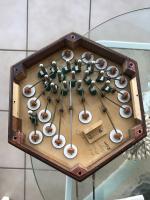Search the Community
Showing results for tags 'tone ring? deflector?'.
-
As many of you know, Harold Herrington in Texas was quite the experimenter when it came to building concertinas, and I think that came from his sincere desire to build something the best way he could even though he didn't play concertina or have much knowledge of historical concertina construction. In fact, the very first 30-button concertina he made back around 1990 had three rows in the keys of A/D/G because he thought Anglos were similar to the melodeon his bandmate played. He was so proud of that instrument and I felt really bad having to break it to him gently that it wasn't the traditional Anglo layout! His first instruments were square, but he quickly learned that the market preferred hexagonal. And yes, he kept changing and modifying to the point where I'm not sure if any two were exactly alike. I'm fortunate enough to have a metal-ended hexagonal 30-button he built in 2000, and it's loud, strong, with bass notes that sound far closer to real concertina reeds than any other hybrid I've played. But I've only recently paid attention to a couple of curious features that might or might not have ever been used on other concertinas. And I'm not talking about the offset lever arms or coil springs (which, by the way, work perfectly well). On the action pan you'll notice an odd little L-shaped wooden baffle/deflector next to the pad of the inboard reed. I've wondered about this for years, obviously an afterthought since it covered up his signature, but my best guess is this was an attempt to deflect/strengthen the volume of that often-weak reed. Anyone ever seen anything like this before? And on each end of the bellows (which he got from Italy) he added an additional plywood piece with a hole in the middle. Perhaps like a banjo tone ring? (Harold was mostly a tenor banjo player). I'm wondering if this has anything to do with the loudness of his instruments? I'm curious to hear what the cnet brain trust thinks about these features, especially from any builders! Gary


